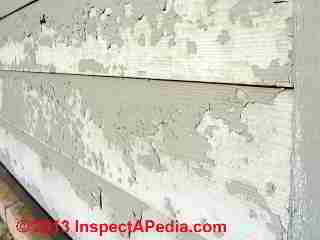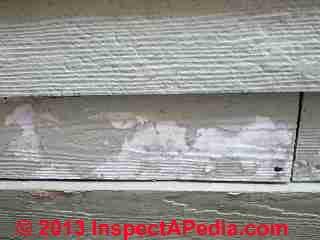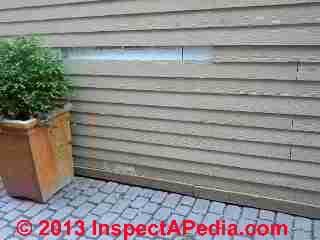 Painting Advice for Asbestos-Cement & Fiber Cement Shingles or Wall Lap Siding
Painting Advice for Asbestos-Cement & Fiber Cement Shingles or Wall Lap Siding
- POST a QUESTION or COMMENT about where to get replacement materials for asbestos cement siding shingles & tools for repair work
Advice for painting fiber cement or asbestos cement building shingles or siding.
In our page top photo of badly peeling paint on fiber cement lap siding, we suspect that the wrong paint was used, the paint was improperly mixed, a primer was needed, or the paint was applied over a chalked or damp surface.
InspectAPedia tolerates no conflicts of interest. We have no relationship with advertisers, products, or services discussed at this website.
- Daniel Friedman, Publisher/Editor/Author - See WHO ARE WE?
Painting Cement Asbestos Shingle Building Siding, Fiber Cement Lap Siding or Shingles
Should I paint my asbestos cement shingles? Do you need to use special paint for cement asbestos siding?
Painting cement asbestos siding or non-asbestos fiber cement siding is in part a cosmetic decision. We have rarely seen this material in a worn, friable condition, but should that occur, one might paint the surface also to stop fiber shedding and to preserve the material.
Or you will have to paint if you are replacing broken fiber cement shingles in a wall that has already been painted. Otherwise the new shingles in their naked primer coat will stand out like a sore thumb.
Our page top photo shows painted fiber cement shingles in a wall where we replaced broken materials.
And of course fiber cement products such as those sold hy GAF (Sources of Replacements for Asbestos Cement Shingles) come with a factory-applied primer intended to be "ready for painting".
Fiber cement shingles, both new non-asbestos product and the older asbestos-cement product are provided from the manufacturer with a coated surface, usually white. When the asbestos cement siding is soiled or moldy or has an algae coating we prefer to gently clean the surface with a sprayer, perhaps a deck cleaner solution.
Watch out: If you use a power washerbe careful to spray "down" (to avoid blowing water into the building walls) and to keep far enough away that you do not damage the siding or "rough it up" which may cause more rapid deterioration or even fiber or asbestos release.
See ASBESTOS CEMENT SHINGLE POWER WASH
And before re-painting be sure that the surface is adequately dry. Latex type paints are a bit more tolerant of slightly damp surfaces than alkyds, but in no case should paint be applied to a wet surface, nor to a surface on which the primer has not thoroughly dried. Making either of those mistakes is likely to lead to a paint adhesion failure or to paint blistering. Details are
at PAINT FALURE, DIAGNOSIS, CURE, PREVENTION
Other problems caused by high-moisture in fiber cement siding are detailed
at SIDING, FIBER CEMENT MOISTURE LEVELS.
But sometimes the asbestos cement or fiber cement shingles just look soiled and do not clean up enough to satisfy the homeowner. In general, this siding material can be painted using normal house paints.
Check with your paint suppliers because some paints may not be recommended for the surface.
Be sure to use both a primer and top coat that are recommended for use on cleaned fiber cement siding as recommended by the manfacturer of both the siding and the paint.
Then be sure that the siding is dry before applying either primer or paint.
Watch out: But once you paint the fiber cement or asbetsot cement siding, you've converted a "no maintenance" surface into one that will occasionally need to be re-painted for cosmetic reasons.
On a home we maintained for nearly 20 years, the factory-applied original coating endured perfectly well whereas neighboring homes of the same age and using the same siding but that had been painted required re-painting from time to time.
Paint Failures on Fiber Cement Siding: Factory Coating Failures vs. Installer-Applied Paint Coatings
Paint failures on fiber cement lap siding might be divided into two groups: failure of a factory applied finish coating (rare in our experience), and failure of field-applied paint coatings on bare or factory-primed fiber cement siding.
The peeling top coat on the siding shown above (Rhinebeck, NY) shows a white primer remaining in place on the fiber cement siding. Significantly this paint failure was observed only on the lowest course of lap siding on the building. The peeling siding was installed at the bottom of a wall in an alley into which drained roof eaves.
Details about siding damage from rain splash are
at SIDING DAMAGE by SPLASHBACK
Reader Question/Comment: Delamination or Paint Failures in factory finished fiber cement siding
One of the main ingredients of fibre cement siding is cellulose. Where the product is exposed to direct or indirect water, snow or ice, the possibility of the fiber cement siding absorbing moisture exists.
This may cause the siding to swell, crumble or result in loss of paint adhesion. The core raw material of fiber cement siding is grayish in colour. When delamination occurs, it is easy to see these areas in contrast to the painted finish. - Hugh Cairns, Subject 2 Inspections, Email: customercare@subject2homeinspections.com, Tel: 250-808-5777
Mr. Cairns is a Canadian home inspector located in B.C. and is an occasional contributor to InspectAPedia.com. Also see his photographs
Reply: diagnose the cause of paint failure; protect fiber cement siding paint coatings from early failures
Thanks for the comments, Hugh. The manufacturer, e.g. James Hardie, points out that their product must be protected from moisture prior to installation and that improper jobsite storage can result in product shrinkage and shrinkage gaps after installation.
Certainly one has to agree that the siding in your photos has undergone a terrible paint failure. Can you confirm that this was a factory-finished product, and can you confirm the product brand name?
At SIDING, FIBER CEMENT MAINTENANCE we include details about steps to avoid early paint failures on fiber cement siding.
The actual siding board delamination problems we see seem to concentrate in hardboard siding products whereas in fiber cement siding boards I'm seeing and receiving reports of shrinkage, gaps, and coating failures.
A detailed report on that failure problem is found
If you can send along some sharp photos of actual fiberboard swelling and delamination, or if you can send me a siding sample, even a paint sample from the home in your photos, we'd be glad to take a close-up look in our forensic lab. Often a forensic microscopic examination of paint samples from a paint failure surface can tell us just why the paint is coming off of the surface to which it was applied.
For example, we can distinguish easily among adhesion failiures, paint over caulked surfaces, paint over dirt, and paint over primer that had not adquately dried. Simple microchemical tests can also quickly identify some basic paint incompatabilities between layers of paint coatings or between a paint and a primer coat.
...
Continue reading at FIBER CEMENT SHINGLE CUTTING TOOLS or select a topic from the closely-related articles below, or see the complete ARTICLE INDEX.
Or see these
Recommended Articles
- ASBESTOS ROOFING / SIDING DUST
- PAINT & STAIN GUIDE, EXTERIOR
- SIDING DAMAGE by SPLASHBACK
- SIDING, FIBER CEMENT - home
- SIDING, FIBER CEMENT SHINGLE DEFECT DIAGNOSIS
- SIDING, FIBER CEMENT DEFECTS - home
Suggested citation for this web page
FIBER CEMENT SIDING PAINTS at InspectApedia.com - online encyclopedia of building & environmental inspection, testing, diagnosis, repair, & problem prevention advice.
Or see this
INDEX to RELATED ARTICLES: ARTICLE INDEX to BUILDING SIDING
Or use the SEARCH BOX found below to Ask a Question or Search InspectApedia
Ask a Question or Search InspectApedia
Try the search box just below, or if you prefer, post a question or comment in the Comments box below and we will respond promptly.
Search the InspectApedia website
Note: appearance of your Comment below may be delayed: if your comment contains an image, photograph, web link, or text that looks to the software as if it might be a web link, your posting will appear after it has been approved by a moderator. Apologies for the delay.
Only one image can be added per comment but you can post as many comments, and therefore images, as you like.
You will not receive a notification when a response to your question has been posted.
Please bookmark this page to make it easy for you to check back for our response.
IF above you see "Comment Form is loading comments..." then COMMENT BOX - countable.ca / bawkbox.com IS NOT WORKING.
In any case you are welcome to send an email directly to us at InspectApedia.com at editor@inspectApedia.com
We'll reply to you directly. Please help us help you by noting, in your email, the URL of the InspectApedia page where you wanted to comment.
Citations & References
In addition to any citations in the article above, a full list is available on request.
- Asbestos products and their history and use in various building materials such as asphalt and vinyl flooring includes discussion which draws on Asbestos, Its Industrial Applications, D.V. Rosato, engineering consultant, Newton, MA, Reinhold Publishing, 1959 Library of Congress Catalog Card No.: 59-12535 (out of print).
- "Handling Asbestos-Containing roofing material - an update", Carl Good, NRCA Associate Executive Director, Professional Roofing, February 1992, p. 38-43
- EPA Guidance for Controlling Asbestos-Containing Materials in buildings, NIAST, National Institute on Abatement Sciences & Technology, [republishing EPA public documents] 1985 ed., Exposure Evaluation Division, Office of Toxic Substances, Office of Pesticides and Toxic Substances, U.S. Environmental Protection Agency, Washington,D.C. 20460
- EPA, ASBESTOS IN YOUR HOME [PDF] - U.S. EPA, Exposure Evaluation Division, Office of Toxic Substances, Office of Pesticides and Toxic Substances, U.S. Environmental Protection Agency, Washington,D.C. 20460
- NRCA Roofing and Waterproofing Manual, 4th Ed., available from the National Roofing Contractors' Association.
- "Tips for working with fiber-cement roofing products", Thomas L. Smith, AIA, RRC, Professional Roofing, September 1996
- Bullet Tools 920 Pro Magnum Shear I-20 Electricity Free 20 Inch Flooring and Siding Dust Free Cutter -(sold at Amazon and at other tool distributors) this is a great tool, but $900. http://www.bullettools.com/ Bullet Tools Company, 3390 W. Hayden Ave., Hayden ID 83835 - 800-406-8998 or international: 208-772-0175. sales@bullettools.com
- Malco® TSFC Tubo Shear fiber cement cutting tool (sold at Amazon and at other tool distributors) and also the Malco TSF2A Shear Cutting Tool, a heavy-duty pneumatic shear cutting tool for the same purpose (available at Amazon.com) Malco Products, http://www.malcoproducts.com/ specializes in producing tools for the HVAC trade. Malco Products, Inc. - PO Box 400, 14080 State Highway 55 NW, Annandale, MN 55302-0400 P: 800-328-3530 | F: 320-274-2269
- Makita JS8000 Fiber Cement Shear Kit (variable speed) (sold at Amazon and at other tool distributors)
- Kett 1/2 Capacity Steel Shear Head #93 20 - (sold at Amazon and at other tool distributors)
- Kett Electric Fiber Cement Cutting Shears - 120 Volt, 5 Amp, Model# KD-29 - (sold at Amazon and at other tool distributors)
- Kett Fiber Cement Shears KD 1495 - (drill powered)- (sold at Amazon and at other tool distributors)
- Snapper Inc SS204 Fiber Cement Siding Shear Hardi Board cutter.- (sold at tool distributors)
- Thanks to reader Van Moore for suggesting clarification of our text on how cementious asbestos-containing materials become friable and unsafe 4/15/2010
- June 1997 - Window Putty - OSHA case cites contractor for asbestos exposure during removal of window putty http://www.osha.gov/pls/oshaweb/owadisp.show_document?p_table=NEWS_RELEASES&p_id=1091
- ASBESTOS IN YOUR HOME U.S. EPA, Exposure Evaluation Division, Office of Toxic Substances, Office of Pesticides and Toxic Substances, U.S. Environmental Protection Agency, Washington,D.C. 20460
- Asbestos products and their history and use in various building materials such as asphalt and vinyl flooring includes discussion which draws on ASBESTOS, ITS INDUSTRIAL APPLICATIONS, ROSATO 1959, D.V. Rosato, engineering consultant, Newton, MA, Reinhold Publishing, 1959 Library of Congress Catalog Card No.: 59-12535 (out of print, text and images available at InspectAPedia.com).
- "Handling Asbestos-Containing roofing material - an update", Carl Good, NRCA Associate Executive Director, Professional Roofing, February 1992, p. 38-43
- EPA Guidance for Controlling Asbestos-Containing Materials in buildings, NIAST, National Institute on Abatement Sciences & Technology, [republishing EPA public documents] 1985 ed., Exposure Evaluation Division, Office of Toxic Substances, Office of Pesticides and Toxic Substances, U.S. Environmental Protection Agency, Washington,D.C. 20460
- In addition to citations & references found in this article, see the research citations given at the end of the related articles found at our suggested
CONTINUE READING or RECOMMENDED ARTICLES. - In addition to citations & references found in this article, see the research citations given at the end of the related articles found at our suggested
CONTINUE READING or RECOMMENDED ARTICLES.
- Carson, Dunlop & Associates Ltd., 120 Carlton Street Suite 407, Toronto ON M5A 4K2. Tel: (416) 964-9415 1-800-268-7070 Email: info@carsondunlop.com. Alan Carson is a past president of ASHI, the American Society of Home Inspectors.
Thanks to Alan Carson and Bob Dunlop, for permission for InspectAPedia to use text excerpts from The HOME REFERENCE BOOK - the Encyclopedia of Homes and to use illustrations from The ILLUSTRATED HOME .
Carson Dunlop Associates provides extensive home inspection education and report writing material. In gratitude we provide links to tsome Carson Dunlop Associates products and services.





